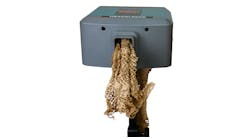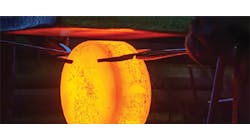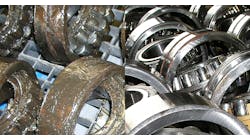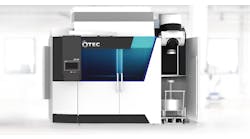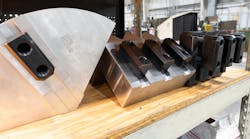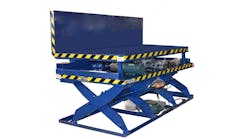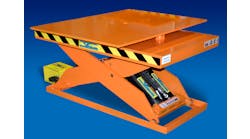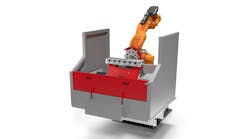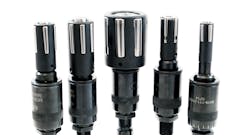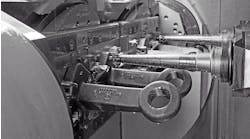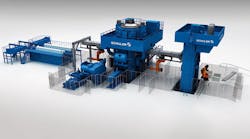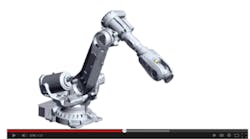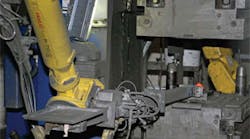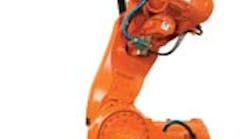The “most modern forging line” in Europe has been designed by Schuler AG and is in development, for installation at Parsan Steel Forging and Machining Co., a Turkish manufacturer of automotive parts, like front axle beams and assemblies. Schuler, describes the project as the largest ever received by its forging machinery division in Weingarten, Germany, and indicated it will complete delivery by early next year.
The new installation will be series of three presses, forming various engineered parts for the heavy truck sector. Two of the presses 2,500-metric ton hydraulic operations, and the third one — described as “the heart” of the new line — will be a 16,000-metric-ton screw press, forming products like crankshafts, front axles, steering knuckles and flanges. After the large press forms the parts they will be deburred and finished (“calibrated,” according to Schuler) by the two supporting machines.
The line will run about 70 meters in length, and will be fully automated with a cycle speed of about 35 seconds. Process controls to oversee the complex production sequence were developed by the group, too. “There is nothing like this line in the field of forging,” according to Schuler managing director Jochen Früh.
That may prove to be true once the line is in operation, but consider: Elsewhere in Turkey, for Karabük Iron & Steel, Schuler also is developing a high-volume production line for railway wheels. The innovation in that line is seen as a new wheel rolling machine design, but the entire installation includes three hydraulic presses for sequential forming of the blanks prior to rolling. Handling the product from one stage to another is just as critical to the production process as the effectiveness of the heating or forging operations.
SMS Meer has a new railway wheel line in operation now for Taiyuan Heavy Industry, another high-throughput design in which the production targets are defined as much by the effectiveness of the sequence as by the forming processes.
For the Parsan Steel Forging installation, Schuler has dictated a set of robots that will transport the parts in production, weighing 150 to 250 kg between the induction furnaces and the individual presses.
Redefining Roles
The role of automation in forging production is not new: hot and heavy parts need to be handle efficiently. But, designers of high-volume forging lines are gaining the advantage of recent developments in robotics that make such machines more effective role players.
Recently ABB Robotics — one of the developers of industrial-scale automation devices capable of handling large and heavy objects in hot and caustic surroundings — introduced a new line of robots, following a thorough redesign of its products. The IRB 6700 family is capable of handling payloads from 150 to 300 kg and achieves an effective reach of up to 3.2 meters (about 10 feet.) The developer emphasizes these new machines’ energy efficiency and reduced maintenance requirements, but the redesign program also incorporated other recent details in robotic design.
The first is the collision-resistance: robots that are designed to interact with other machines must be able to avoid contact the machines while handling the interchange of workpieces that is the objective of a high-throughput design. The most advanced robots now available make better use of sensor technology to avoid crashing with the other moving parts of the production process, and this capability not only facilitates high throughput; it also reduces damage to machines, tooling, and material.
Beyond the sensors, robots’ functions are improved by advances in power- or force-limiting controls that minimize contact with objects (or, workers), which gives a considerable boost to the robots’ ability to operate collaboratively with other systems.
Rethink Robotics is a developer of interactive robotic devices. It recently issued a new programming software update that it said introduces applications for its ‘Baxter’ prototype interactive robot. This device is able to pick and place parts at any axis, allowing the robot to perform innumerable tasks for handling different types of objects, which naturally establishes more opportunities for designing flexible production lines.
The 2.0 software also allows machine operators or programmers to define waypoints with more accuracy: they can define an exact trajectory for a robot’s arm to follow simply by moving them. It can be taught where to move its arms in and out of a machine.
The range of motions that robots can achieve is another line progress in automation technology. Developers of robots used in pick-and-place or spot-welding processes are gaining great advantage by using digital servo drives, servo controls, and servo control systems, which manage movement as well as speed and positioning with more reliability, and this in tandem with the greater range of motion adds further to robots ability to enhance high-speed, high-volume production — like forging lines.
In its development of a new robot series, ABB Robotics relied heavily on users’ experience. Thus, the new models incorporate smaller footprints and easier programming, meaning that the machines’ presence in a workplace is more adaptable to any changes that may be required to the production process.
“Our aim from the beginning was to deliver a robot with the lowest total cost of ownership available,” ABB Robotics product manager Ola Svanström explained. “When we asked our customers what they value most in our large robots their answer was virtually unanimous: reliability. So, we revisited every aspect of our current range to improve everything we could in this regard. It may not look that different from its predecessor on the outside, but the hundreds of small improvements on the inside are what count.”
